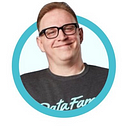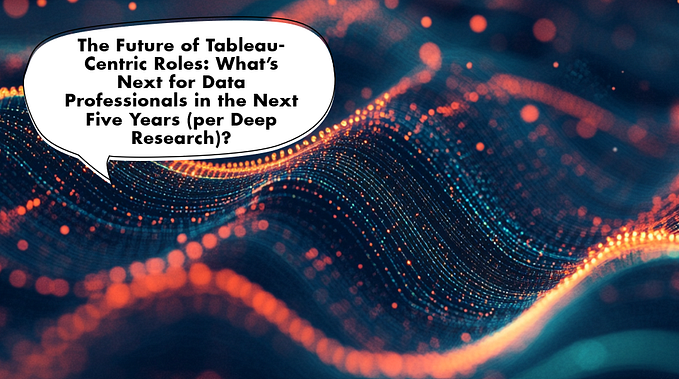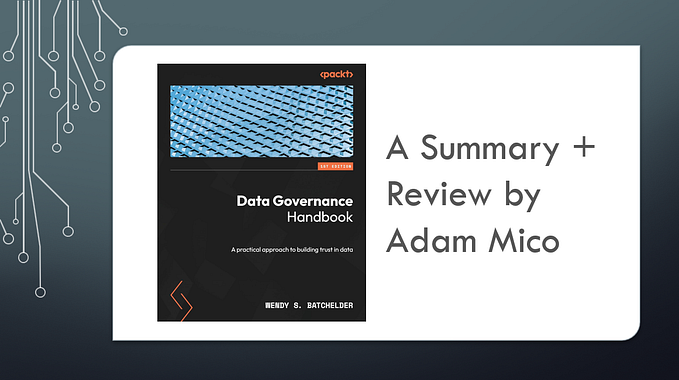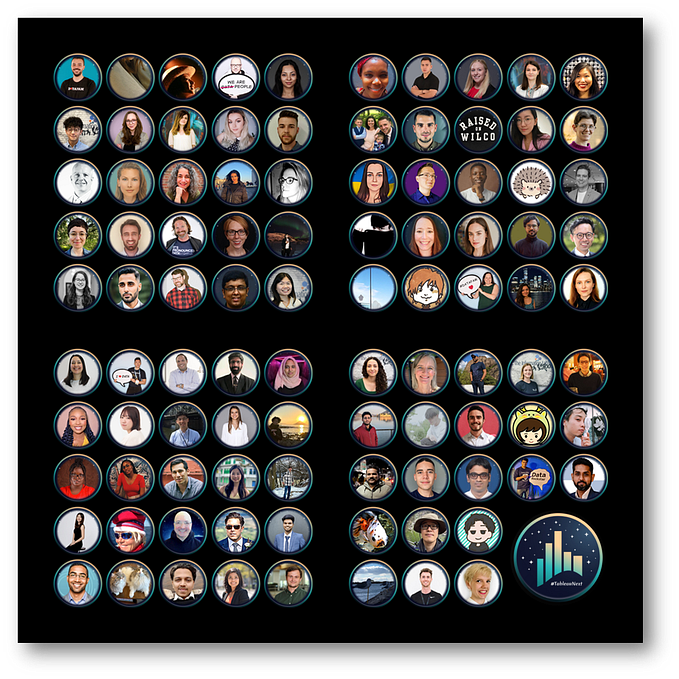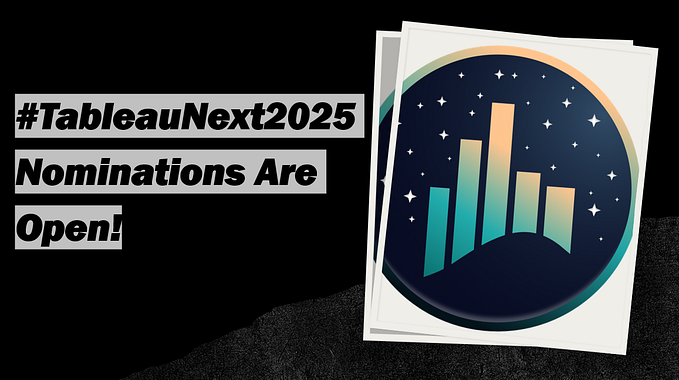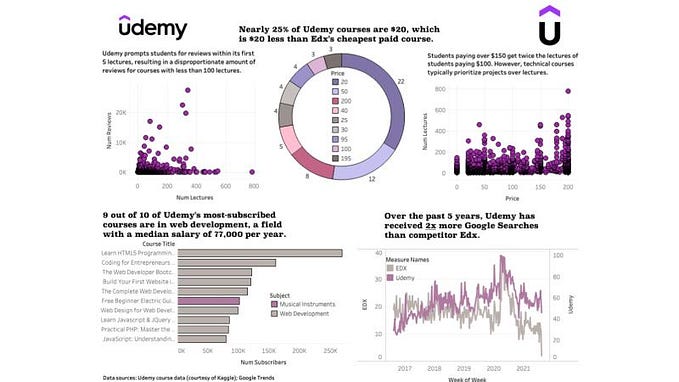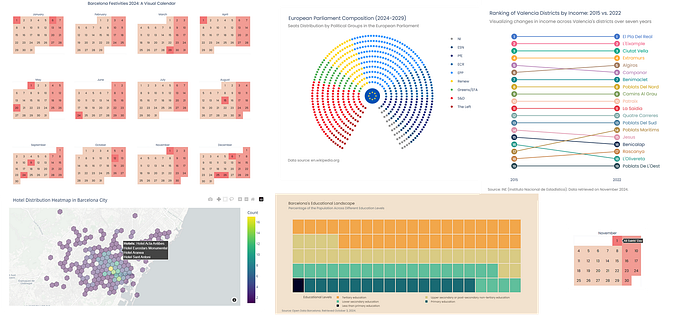An Interview with Bridget Cogley (A 5-Time Tableau Zen Master and Data Ethicist)
A weekly blog about the ‘data viz’-making process, #datafam / data analytics member interviews, & entertainment for introverts (consisting of a music morsel & a binge bite).
Feature Interview

Mico’s Intro: Bridget Cogley (Twitter | LinkedIn | Tableau Public | Blog) is someone who has had an immense impact on me since I began with the community. She made me think of the #DataFam as more than a bunch of folks sharing Tableau data visualizations, but something much more impactful and real. In many ways, we are quite different, but ultimately want many of the same results. Her words, intent, and thought-processing force me to think a little differently and care even more about our community and world a little deeper. She helped me understand and care about what a thought leader does and represents. It’s an honor and a privilege to share her inisghts with you on this blog.
Adam Mico (AM): You have worked as a Senior Consultant for Teknion Data Solutions since 2016. You began your work career as an ASL interpreter. I love a unique origin path. Please explain how you encountered Tableau and if/how your ASL interpreter work continues to have an impact on your work and its approach currently.
Bridget Cogley (BC): Technically, my career started in retail and it was Deaf friends that steered me into interpreting. One of the best things I did early enough in my career was going to work for a startup. I’d been freelancing for a bit when I joined the company in 2005 as their first ASL interpreter. At that company, I covered a wide swath of roles, including training, management, HR, business development, compliance, and eventually covered reporting. You know how it goes — you build a report factory to the point where your whole job is administering that and you’re not creating or innovating. We tried out many solutions and landed on Tableau in 2010 — we waited for Version 6.0 to release and signed the deal.
I didn’t come into analysis in what gets marketed as the traditional way: I learned everything on the job, which included a blend of Six Sigma, working under the CFO, and co-creating with clients before that was fashionable. ASL interpretation plays a heavy role in how I think about presenting data. It’s one of the reasons I’m working on a book with Vidya Setlur (Twitter | Site) focused on harnessing perception, semantics, and intent as a way to create more effective visualizations. Beyond getting all the charts right, we have to expose meaning in a way those using the visualizations understand. Sometimes, the way we achieve this is the “10 seconds to meaning rule,” but more often than not, it’s creating expositions that guide users to understanding. Interpreting focuses a lot on ensuring meaning and intent are preserved and is definitely the foundation I leverage today for creating analyses. I’m so excited to cite Deaf scholars in my book, as well as bring in interpreting models.
AM: When did you start working with Tableau and how does Tableau continue to play a role in your day-to-day work?
BC: I started working with Tableau in 2010 before our area even had a user group and paper materials were commonly passed out around launches. Yes, paper. I remember the first meeting of the Columbus TUG. We all went around the room, introducing ourselves. This one was 2 months, another 3 weeks, that person 1 week, and then I stood up: 9 months and the room clamored. I knew so little and was so relieved when Michael Cristiani stood up and casually mentioned using Tableau since Version 2.0. He also asked a question about maps that blew my mind and I KNEW I needed to chat with him.
In the early days, I worked as the sole fractional analyst, creating both internal and external reports, along with several other duties. I used Tableau as a small part of my job, but lemme tell you, I made that small part count as much as I could. I’d respond to grants and sales requests where I included visuals from Tableau as part of my response. I had data curated on interpreter availability, immigrant population shifts, and Centers of Medicaid and Medicare & Medicaid Services (CMS) reimbursements. During the H1N1 outbreak, we used data to plan outreach and education services to mitigate infections. At that job, we had hiring calculators, ROI tools for clients, and many internal reports.
I wanted to do more with Tableau and left a job reporting directly to the COO. I had my own office with a door and team and left to go do consulting over 7 years ago. Now, I get to bring a wide number of things, including presenting data science. I definitely still make dashboards in Tableau, but I’m often helping clients think more holistically about analysis, visualization, and its role in the organization. I’ve worked with Joshua Milligan (Twitter | Site) to develop this strategy piece into an assessment that builds out a roadmap. Of course, the assessment uses Tableau to showcase results.
Priya Padham (PP): What was your most difficult viz and which viz are you most proud of?
BC: Can one viz answer both questions? My hardest viz — but the one that matters most to me — is honestly the one that terrifies other people. It’s the viz I made while providing hospice for Kelly Martin.

I started ‘the working of’ that one after a particularly hard day. I needed a way to see the pattern (if there was one) and turned to Tableau. It moved from being a single chart to a full dashboard suite that showed patterns with medicine use, but also tracked our inventory. It went from a little self-therapy to something that helped Beau (Kelly’s son) and I better realize what symptoms were and how they could best be treated. That viz made a few lives easier at a critical junction. It’s not the prettiest viz or even the most technically challenging, but it’s one that profoundly showcases how I think about data and even had feedback from Kelly to make it better. We used it weekly with the doctor and nursing team.
It also took that viz to identify a key symptom and its proper treatment. There would be no other way to identify that pattern without visualization. On the surface, it seemed like one medication should treat it, but we found it was actually a different one. Beyond insight, we did something directly good and tangible with data, and this was one of many reasons Kelly wanted it out there.
AM: Although I began in the community shortly before Kelly Martin passed away, but realize her impact was significant on the community and you, her closest friend. What has the community lost with her and what impact does she still have today?
BC: The community lost a lot. Kelly’s sense of humor was unrivaled and her blog provided a ton of wisdom with a lot of giggles. It’s something I aspire to with mine. She really had a way with words and nothing was off-limits. She embedded her worldview in her blog, openly and honestly.
There’s another piece that I worry we’ve forgotten: that the modern Tableau designs we hold up high owe a huge debt to her keen eye and desire for something beautiful while providing analytic depth. When floating came out, she bloomed. The bird-plane viz came out, there was nothing else like it at the time. Her work has aged well. I still see clients using her 9-box template nearly a decade later. Her mobile designs are other-worldly, and her last big work still looks like something we’d see and celebrate 5 years later. I’ve analyzed her work extensively and the theories from those analyses are going into the book.
Kelly broke a lot of boundaries with her designs. She did it while having fun and a ton of laughs. She was a demographer and did a quantitative thesis. She cared about accuracy, but felt strongly that, “beauty is meaningful design.” She also made a space for numerous women who came behind her. It’s easy to forget now with the growing diversity we have in the numerous recognition programs, but I remember celebrating having 5 women and 27 men who were predominantly white and in the US and UK in the Tableau Zen program as progress. Kelly started by breaking that wall.
She was also incredibly kind and thought a lot about the effects of her actions. I have a sticky note from her that I cherish which really highlights how she reflected on her actions and centered kindness. Between that and the hours of laughter, I miss her daily.
AM: You have been part of our Tableau community for quite some time. How has the ‘social media’ communal pulse changed in that time and what do you miss from those early days of what would be ultimately regarded as the #datafam?
BC: It’s grown a lot. Those of us on Twitter can thank Michael Cristiani for creating a lot of the culture: the willingness to drive and meet, the ability to get quick help, and for being welcoming. It’s grown a lot larger since I first dipped my toe in back in 2012 and there are definitely lots of subcommunities for newer members to acclimate. We’ve gone fully global and I’m excited to see more tweets in a growing number of languages.
I miss some of the humor from the early days, as well as some of the more in-depth conversations. Autumn Battani (Twitter | Site) embodies some of that older ethos of community building, humor, while still pressing for us to improve. She’s definitely one of my data heroes. I enjoyed Chris Love’s Data Dump (Twitter | Site) chats that he and others like Sarah Nell-Rodriguez (Twitter) have hosted. I hope those come back.
There are a lot of people that have cycled in and out over the years and it’s easy to get lost in the shuffle. The less you’re reflected by those around you, the easier it is to vanish. I miss those voices we lost before we ever truly saw and celebrated them.
AM: You have been a Zen Master since 2016. What impact has that title had on you and what doesn’t it provide?
BC: When I first got the email in 2016, I couldn’t believe it. I emailed Andy Cotgreave back to make sure he had the right person. It’s a humbling honor and one I didn’t expect. The imposter syndrome is strong when you go from one field to the next and quite frankly, I’ve never been a cool kid in my life. I didn’t really see myself reflected in the room throughout most of my career. Kelly had the same hair, wit, and could talk about nearly anything. She was the first time I really saw myself reflected anywhere.
It’s a big reason I push for representation, and balance and belonging within recognition. It’s a lot easier to be something when you see someone like you in the first place.
For me, the title provided some credibility to the work I was doing and some of the theories I have about data visualization, particularly since I don’t have a more traditional degree in a seemingly related field. I suspect it did more for me than it does others, mostly because it opened a few key doors I’d been banging on before that wouldn’t open. For years, I’ve had to defend my story and background — the honor definitely shortens the defense. The title still doesn’t make window calculations or containers easier. I still don’t enjoy both of those. Most of my clients don’t know or understand what the ‘Zen Master’ recognition means.
More importantly, I worry sometimes, it separates me from others in a bad way or that others are hurt when not recognized. For example, Michael Cristiani gave so much to this community and was never seen — that hurts so much knowing what he gave. I know others run into the same and I can’t tell you what the formula is to achieving it because I honestly don’t know. Somehow, I’ve been selected for 5 years, which surprises me every time. This is my last year on this side of the program. Next year, I’m either out or HOF. My goal this year is to further elevate and grow the next generation.
AM: Your blog, Tableau Fit, is a little of everything, but what stands out is that it is beautifully written and with seemingly considered words. I have come across it before I joined the community in August 2019, but when I see new updates, it has hit differently. It hits in a way others cannot. How important is it for you to deliver words with a heartbeat rather than just a brain wave?
BC: On the Hamilton Mixtape, there’s a song called “Wrote my way out,” based on “Hurricane” from the play itself. My whole life has been writing my way out — out from poverty, into college, and even throughout work. I’m the first generation of my family to go to college and I did it while working at least 1 full-time job. We ran out of books when I was a child, so I even read the dictionary. I spent years writing poetry, and one of my early ways of getting promoted at work was down to my ability to write.
In my first year of blogging, I published 22 posts. I was still trying to find my ground and path, raising a small child, and needing a way to figure out a way forward. I wrote my way out from uncertainty and out of a lot of the struggles we had. The blog is my security, my wayfinding in the world, but also hopefully a klaxon to others to know they exist out there. It’s also where I continue to have my professional identity crisis around what to title myself.
The words on the blog are definitely heavily considered. We read so much now, what with social media and the general proliferation of words online. I want to leave a fingerprint and a memory, for people to preserve how they feel when they come to the blog.
It’s what I get from Kelly’s writing, and what I hope people get from mine. My favorite posts are the funny ones and the ethics ones usually come from existential duress. If Chidi and Eleanor of “The Good Place” had a child, I’d be it, complete with peeps chili and random shirt grabbed out of need.
AM: You are a data ethicist. Many people may consider themselves inherently an ethicist by providing vetted facts. Why do data facts not make the data delivery ethical and what’s a good example of complex data ethically delivered?
BC: Here’s a riddle for you: the first time I learned about ethics was from a philosophy class in high school. I was broke, working to pay the bills, hungry in a lot of ways, so naturally, I stole the book. Sit with that. It’s an ethical puzzle right there. Later, I took an applied ethics course in college as part of my interpreting major (and paid dearly for the books). Ethics done right should keep you up at night, especially when you realize the potential harms you directly can cause. Too many of us are lulled into not realizing the harms we create, blanketed by the soft comforts of good intentions while others face the tacks and pains we leave behind. You see it very tangibly with interpreting, whereas with data, it’s easier to point to the medium. Pema Chodron talks a lot about getting pinned by life and sitting with the discomfort.
The challenge with data is that it’s not neutral, even though we’re often sold that it is. We humans choose what we collect, how it’s collected, and what is overtly not considered. All of this informs our analyses.
Hannah Fry recently wrote an article, where she discussed a survey about violence against women. A part of it examined specific types of violence. Some types are specific to certain areas, such as throwing acid on women or banishing them to animal pastures. These responses didn’t make it into the survey, which begins to show you we can’t measure what we don’t collect. It wasn’t collected in part because people making the survey let their own taboo, ethnocentrism, and emotions affect what was collected with the data. Data is not neutral, raw, or mined: it’s cultivated from the start. The sooner we understand what isn’t in the data and the biases we inject into it, the better job we’ll do.
With interpreting, it’s easy to see the language transformation. What’s hard to see is what else goes into that rendition, and trust is pivotal. There’s an expression I learned very early with interpreting: you can’t be neutral on a moving train. The reality is things will happen and you have to react in real time. Opting not to act is still choosing. Data, too, is a moving train. The amount of data we have, what assumptions are baked in, and how it’s used all fuel the train. We can opt to totally ignore this, but that’s still a choice. Data ethics require us to acknowledge that.
I have several examples I hold up as amazing vizzes that incorporate ethics. Kate Brown (Twitter | Site) did a Makeover Monday some time back that really nails it. Her visualization opens with “you are not a statistic” and walks through how it’s interpreted when getting that diagnosis, something not addressed by any other rendition. We can recognize the emotion, but it’s also how that emotion affects navigation, which is the critical piece. Alex Dixon has done a few pieces that are still currently offline where he’s dug into history and taken great care with terms and presentation. David Pires (Twitter | Site) and his Expedia Group cohort took a look at data affecting Covid travels and shared a comprehensive dashboard I love in execution. He labeled his sources, what they mean, and exposes them beyond the basic KPIs. I’m a huge fan of the work Candra McRae (Twitter | Site) does around social justice and racial equity. I learned a ton while collaborating with her on the Juneteenth viz. We chatted about some of the terms used in data sources and how to address that and that the timeline emphasized generations rather than decades. These details aren’t merely stylistic but intersect directly into the ethical questions of who gets centered in a message.
AM & PP: Who are your ‘go-to’ people you always seek out in our community for inspiration and how do they inspire you?
BC: The easy answer: Kelly Martin’s work from now until forever.
The more nuanced answer, that’s likely to create trouble…I know I’m going to forget a ton of people and apologies beforehand. So Kelly and…
Candra McRae’s investigations into social justice — make me want to be a better human and analyst. Michelle Frayman (Twitter | Tableau Public) for her endless support to others and various methods around providing feedback (including shared office hours with fellow Columbusite Zak Geis (Twitter |Site)] — she reminds me in many ways of both Joe Mako and Michael Cristiani. Allen Hillery (Twitter | Blog) focuses so much on bringing data literacy to the masses, particularly to those typically left out of the picture. He also helped drive the WEB Du Bois initiative and does such thoughtful investigations into history. Lilach Manheim (Twitter | Site) for her semantically resonant vizzes and for how she thinks about data visualization in the first place. Dr. (I may be early on the title but I’m going all-in on it) Young Song’s (Twitter | Tableau Public) science communication vizzes — it’s not often you have someone expose bits of a thesis through Tableau. I love the style and learning from him. Dr. Katherine Peterson’s (Twitter | Tableau Public) — also another scientist going from microscope to Tableau — genomic Venn Waffles and other works using Tableau to find patterns in macular degeneration inspire me to no end. Lindsey Poulter (Twitter | Site) and Hesham Issa’s (Twitter| Site) explorations into D3, because, no lie, I am a sucker for some good D3 work. Autumn Battani plays with sketching, but her Tableau expositions are beautiful and heavily analyzed. Josh Smith (Twitter | Site) (also Columbus-based) makes beautiful things, but tells compelling stories (waits for his head to explode) with the data (explosion likely complete). Alex Dixon for all the beautiful work carefully created with ethics top of mind that he’ll someday make public. Seffana Mohamed-Ajaz (Twitter | Tableau Public) does some captivating explorations of both history and pop culture. People like Annabelle Rincon (Twitter | Site), Marian Eerins (Twitter | Site), Sarah Nell-Rodriguez, and Christina Gorga (Twitter | LinkedIn) provide a lot of joy and perspective. Kate Brown because she’s a good human who also enjoys prepping data and she made one of my favorite examples. For some behind-the-scenes work, I’ve been amazed by Jacqui Moore (Twitter | Tableau Public) on a complex data problem. My child also inspires me and is definitely an amazing KidBassador for Tableau. He sees Tableau as a blend between wireframing, social media, and web design. He had me really thinking to solve a random number seed without repeats and his favorite feature is definitely buttons. He’s the one who really sold me on them.
Outside of Tableau, I follow a ton of academics and other brilliant thinkers. Ayodele is another hero that’s writing a book on data ethics.
PP: What music do you enjoy listening to when vizzing or writing?
BC: Lately, I don’t. With everyone home, quiet is a rare commodity. It’s not uncommon for electronic dance music (EDM) to be rolling in my house courtesy of my husband. Pendulum is a favorite, as is Sigma, Giorgio Moroder, and Daft Punk. K-Pop is also common. Yes, BTS, but also Taeyang, Gummy, Blackpink, and others. The child is really into Queen and Cher and is starting to make his own EDM-style songs through Garage Band. Chris Mann has a few Covid parody songs that have helped through much of the pandemic. His rendition of Hello sends me into a fit of laughter every time.
My playlist is so eclectic, it looks like a toddler just hit buttons in one of the stores. There’s Tragically Hip juxtaposed next to Metisse, Black Violin, or Johnny Cash; D’Angelo flowing into Jay Chou, Santana, or Annie Lennox; Nina Simone going to Nightwish, Marshmello, or Richie Campbell. There are songs I’ve collected from friends where even Google can’t identify them. Genre is an impossible construct to me. My child found an old iPod of mine and it’s rocked his world with the variety of music available. Sometimes, I listen to a song to find a particular color, particularly when doing fun vizzes or painting. When writing, certain sounds or emotions from a song may fuel the writing and those songs will often get embedded with the post. Much of 2019 was soundtracked by The Show Must Go On by Queen, 2020 gave Chris Mann’s parodies a lot of plays. Taeyang’s Eyes, Nose, Lips (눈, 코, 입) might win it so far this year.
AM: Please share a guilty pleasure or fun fact that many readers may not know about you?
BC: You mean besides the fact that I’m a horrible tea snob, we ride scooters, renovate houses, and I give an amazing massage? I love people that cook good vegetarian food, especially right now. Seriously, cook for me and I will be your friend forever.

Binge Bite
This documentary film is a difficult, but important watch. Child victims plagued by not only their team doctor, but the USA gymnastics institution, their coaches/caretakers, and even swept under the rug by law enforcement. It’s important to have as many people watch this as possible to help prevent it from happening again.
Music Morsel
Cathedral Bells’ “Dayflower” is a dream-pop morsel with a nice bop to it. It’s a new release but feels familiar and comfortable. I can’t really make out what the lyrics are as the vocals blend into almost part of the sonic scape.
